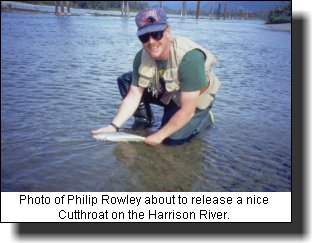
If someone told you of a place were one could fly fish for all 5 species of pacific salmon,
Cutthroat
,
Rainbow
and
Brook trout
,
Dolly Varden
,
Steelhead
and
Smallmouth Bass
would you believe them? What if they said that all of these opportunities were within a 3-hour radius of a major city with a population in excess of 2 million people. You might think they were delusional or exaggerating to say the least.
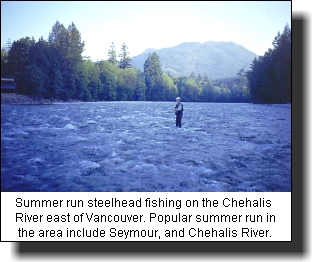 Well, it's true.
Vancouver
Canada offers all of these opportunities and more. People view this major West Coast seaport for many things but not usually fly fishing. Located at the mouth of the Fraser River, the city of Vancouver attracts people from all over the world. In 1995 alone Vancouver attracted over 6.9 million visitors! People from as far away as Japan, Germany Great Britain chose Vancouver as their destination spot. Vancouver has also become a favorite spot for fellow Canadians and our friendly neighbors in the United States. All of these visitors contributed and estimated 2.1 billion dollars towards the local economy. People are perhaps familiar with Vancouver as a stepping off point for the many cruise ships that ply the waters along the West Coast. Many movies and television productions use Vancouver as their backdrop. Others may be more familiar with the resort town of
Whistler
located a few hours north of the city. Whistler is one of the top ski resorts in all of North America. For the non fisher the Vancouver area offers theaters, many fine restaurants, major sporting events such as N.H.L. hockey and N.B.A. basketball plus numerous sight seeing opportunities. With all of these other attractions to draw people it is easy to see why the year round fly fishing opportunities have gone unnoticed by some. Locals certainly are aware of the uniqueness of the region. It can be overwhelming at times trying to decide which species or fly fishing opportunity to sample. Hopefully the following guide will assist you.
Well, it's true.
Vancouver
Canada offers all of these opportunities and more. People view this major West Coast seaport for many things but not usually fly fishing. Located at the mouth of the Fraser River, the city of Vancouver attracts people from all over the world. In 1995 alone Vancouver attracted over 6.9 million visitors! People from as far away as Japan, Germany Great Britain chose Vancouver as their destination spot. Vancouver has also become a favorite spot for fellow Canadians and our friendly neighbors in the United States. All of these visitors contributed and estimated 2.1 billion dollars towards the local economy. People are perhaps familiar with Vancouver as a stepping off point for the many cruise ships that ply the waters along the West Coast. Many movies and television productions use Vancouver as their backdrop. Others may be more familiar with the resort town of
Whistler
located a few hours north of the city. Whistler is one of the top ski resorts in all of North America. For the non fisher the Vancouver area offers theaters, many fine restaurants, major sporting events such as N.H.L. hockey and N.B.A. basketball plus numerous sight seeing opportunities. With all of these other attractions to draw people it is easy to see why the year round fly fishing opportunities have gone unnoticed by some. Locals certainly are aware of the uniqueness of the region. It can be overwhelming at times trying to decide which species or fly fishing opportunity to sample. Hopefully the following guide will assist you.
Species, Opportunities and Seasons
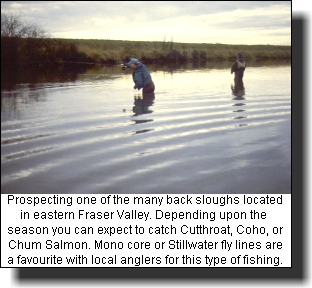 Spring
Spring
From mid March until June there are numerous possibilities for the
fly fisher
. Probably the most sought after species at this time is the
Coastal cutthroat
. You can pursue these nomadic trout throughout the
Fraser Valley
, just 1 to 2 hours east of Vancouver. Some of the more popular spots include the mainstream of the Fraser River and the various back sloughs located along its' Eastern Shore. Nicomen slough runs from just east of Deroche to were it enters into the Fraser near Dewdney. It is a popular destination for local anglers. A car can easily access this area via highway number 7. Other popular spots for cutthroat include the Harrison and Stave rivers. The Harrison is a large, slow moving river that runs south from Harrison Lake to the Fraser River west of the town of Agassiz. It harbors a good population of golden stones (Acroneuria pacifica) as well as 3 spine stickleback and chub fry.
Caddis
,
mayfly
and leeches are also present. Just east of the town of
Mission
, roughly 1.5 hours east of Vancouver is the Stave River. The Stave is a tailwater that flows into the Fraser River. It is a fast flowing river that is subject to rapid fluctuations in water level due to local hydro demands. Wade with caution especially during low water conditions. The back sloughs have 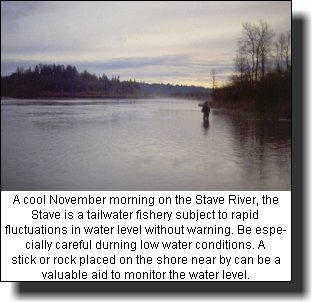 some flow and are almost lake-like, traditional stillwater patterns for
chironomids
,
damsels
and
dragon flies
are a good bet. The highlight of the spring cutthroat season is the annual downstream migration of the
Chum
and
Pink salmon
fry. Fry of these species shoot out to sea and the opportunistic cutthroat are there to great them. Aggressive Cutthroat slash through schools of fry and any silver bodied streamer in sizes 8-10 draws a response early in the migration. But as the migration of fry progresses the more selective the fish become to both patterns and presentation. This characteristic has created a loyal following of Cutthroat anglers constantly trying to outwit these pretty fish. Tackle usually ranges in the 5-6 weight range. With floating or sink tip lines being the norm. A good selection of nymphs such as the venerable Hare's ear and Idaho nymph work well. Streamers such as the Tied Down Minnow, Mickey Finn, Zonkers and the reliable Woolly Bugger form a good starting point. It doesn't hurt to have some wet flys such as the Doc Spratley and Professors either.
some flow and are almost lake-like, traditional stillwater patterns for
chironomids
,
damsels
and
dragon flies
are a good bet. The highlight of the spring cutthroat season is the annual downstream migration of the
Chum
and
Pink salmon
fry. Fry of these species shoot out to sea and the opportunistic cutthroat are there to great them. Aggressive Cutthroat slash through schools of fry and any silver bodied streamer in sizes 8-10 draws a response early in the migration. But as the migration of fry progresses the more selective the fish become to both patterns and presentation. This characteristic has created a loyal following of Cutthroat anglers constantly trying to outwit these pretty fish. Tackle usually ranges in the 5-6 weight range. With floating or sink tip lines being the norm. A good selection of nymphs such as the venerable Hare's ear and Idaho nymph work well. Streamers such as the Tied Down Minnow, Mickey Finn, Zonkers and the reliable Woolly Bugger form a good starting point. It doesn't hurt to have some wet flys such as the Doc Spratley and Professors either.
There are many coastal lakes to try too. While the trout are not huge they can be great fun on a 5 weight system. A good selection of impressionistic nymphs, leeches, and Woolly Buggers should see you successful. Some of the lakes contain populations of Stickleback and Peamouth Chub so as with the river cutthroat don't forget some Zonkers or Rolled Muddlers, in sizes 10 through 6. Due to the geographic make up of these coastal lakes full sinking lines such as a type 2 uniform sink work well. Depending upon the lake it is possible to catch Rainbow, Dolly Varden, Coastal cutthroat, and in some cases Brookies. Most of the lakes are within a 2 hour radius of the city with some good fishing available within the city limits of the local municipalities. Some of the more
popular lakes
include
Buntzen
, Sasamat, Sayers,
Hicks
, Salisbury and
Rolley
. Towards the end of the spring some of the low lying lakes in the
Squamish
area north of Vancouver become ice free. Try
Alice
and Stump lakes. Almost all of these lakes offer easy access although a float tube would be advisable as not all lakes offer shoreline angling opportunities.
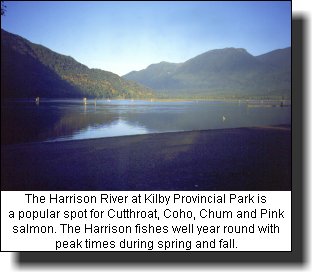 If you don't mind taking a ferry boat ride you can even get yourself into some great Smallmouth fishing on
Saltspring Island
. The scenic 1.5 hour ride is worth it alone. It is not unusual to see concentrations of
Bald eagles
, seals and
Killer whales
along the way.
St. Mary's lake
is the largest on the island and has both Rainbows and Smallmouth bass to 4 pounds or better. As the Smallmouth move into the shallows prior to spawning the surface action on surface poppers and divers can be heart stopping. Don't discount the Rainbows in the lake either as they always give a good account of themselves. St. Mary's lake has a number of resorts and Saltspring Island itself is a unique place unto itself. Besides St. Mary's lake there are other lakes worth exploring and beach fishing for sea run Cutthroat trout.
If you don't mind taking a ferry boat ride you can even get yourself into some great Smallmouth fishing on
Saltspring Island
. The scenic 1.5 hour ride is worth it alone. It is not unusual to see concentrations of
Bald eagles
, seals and
Killer whales
along the way.
St. Mary's lake
is the largest on the island and has both Rainbows and Smallmouth bass to 4 pounds or better. As the Smallmouth move into the shallows prior to spawning the surface action on surface poppers and divers can be heart stopping. Don't discount the Rainbows in the lake either as they always give a good account of themselves. St. Mary's lake has a number of resorts and Saltspring Island itself is a unique place unto itself. Besides St. Mary's lake there are other lakes worth exploring and beach fishing for sea run Cutthroat trout.
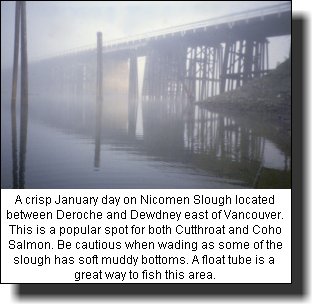 Last but not least the spring season offers the opportunity for some fine steelhead fishing. These beautiful sea run Rainbows can attain weights of 12 pounds or better. Popular rivers include the Vedder or Chilliwack River 2 hours east of Vancouver and the Squamish/Cheakamus River 1 to 1.5 hours north of the city. The Vedder run is in full swing by spring. Be warned however this is a hatchery supported run and is subject to heavy pressure at times. On weekends many locals echo the phrase, "bring your own rock". However you should be able to sample some untouched water during mid week if you have the opportunity. The Squamish and Cheakamus River run is a late spring affair with the bulk of the run usually arriving by mid April. It is generally not as crowded as the Vedder/Chilliwack system. The Squamish is a beautiful river to fish. Standing in the river it is possible to see mountain goats, deer, immense numbers of Bald eagles and even the occasional Black or Grizzly bear. Typical West Coast steelhead tackle will do for these magnificent fish. Both single and two handed rods are popular. Popular fly patterns include General Practitioners, Squamish Poachers, marabou patterns such as Popsicles and egg patterns.
Last but not least the spring season offers the opportunity for some fine steelhead fishing. These beautiful sea run Rainbows can attain weights of 12 pounds or better. Popular rivers include the Vedder or Chilliwack River 2 hours east of Vancouver and the Squamish/Cheakamus River 1 to 1.5 hours north of the city. The Vedder run is in full swing by spring. Be warned however this is a hatchery supported run and is subject to heavy pressure at times. On weekends many locals echo the phrase, "bring your own rock". However you should be able to sample some untouched water during mid week if you have the opportunity. The Squamish and Cheakamus River run is a late spring affair with the bulk of the run usually arriving by mid April. It is generally not as crowded as the Vedder/Chilliwack system. The Squamish is a beautiful river to fish. Standing in the river it is possible to see mountain goats, deer, immense numbers of Bald eagles and even the occasional Black or Grizzly bear. Typical West Coast steelhead tackle will do for these magnificent fish. Both single and two handed rods are popular. Popular fly patterns include General Practitioners, Squamish Poachers, marabou patterns such as Popsicles and egg patterns.
Summer
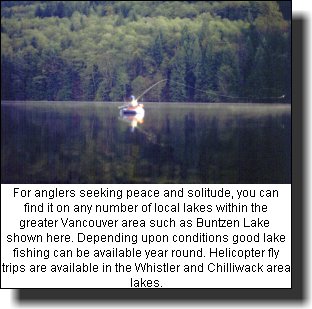 The arrival of summer signifies continuing variety for the visiting fly fisher. For the trout fisher the Skagit River roughly 21/2 hours east of Vancouver near the town of
Hope
is the place to go. It is a catch and release fishery. Over the years anglers have broken the river into two distinct sections, upper and lower. The upper Skagit begins at the Sumallo grove picnic area. From the parking lot anglers walk the path that follows along the entire river. Nestled in a beautiful forest grove the upper Skagit sees less traffic than the lower section. The further you walk along the path the more isolated you can become. I remember fishing a shrouded run one evening only yards away deer came down to the waters' edge for an evening drink. The upper Skagit is a beautiful place to become one with your surroundings. The lower Skagit is more popular with anglers owing to the easy access along a good gravel road. You were once able to drive right to any number of spots along the river. Now there are specific parking areas from which anglers must walk a short distance to the river. The predominant hatch on the Skagit is the Western Green Drake (
Drunella doddsi
). Other insects include caddis and stoneflies. Terrestrial fishing can also be good. For local anglers the Skagit provides almost exclusive dry fly opportunities. However the nymph fisher can do well, especially during the hot dry spells of August. At this time trout hold in the cooler, oxygenated pocket water and riffles. Popular patterns include the Adams, Parachute Adams, Humpies, Royal Wulff and Elk Hair caddis in sizes 12-14. For the nymph fisher it is hard to beat the Hare's ear, Prince nymph or Mike Mercer's Poxyback Green Drake nymph. Popular sizes range from #8 down through #12. Don't forget streamer patterns such as Muddlers as the Skagit is also home to some large Dolly Varden char. One final note, remember your insect repellent. The mosquitoes can be murder.
The arrival of summer signifies continuing variety for the visiting fly fisher. For the trout fisher the Skagit River roughly 21/2 hours east of Vancouver near the town of
Hope
is the place to go. It is a catch and release fishery. Over the years anglers have broken the river into two distinct sections, upper and lower. The upper Skagit begins at the Sumallo grove picnic area. From the parking lot anglers walk the path that follows along the entire river. Nestled in a beautiful forest grove the upper Skagit sees less traffic than the lower section. The further you walk along the path the more isolated you can become. I remember fishing a shrouded run one evening only yards away deer came down to the waters' edge for an evening drink. The upper Skagit is a beautiful place to become one with your surroundings. The lower Skagit is more popular with anglers owing to the easy access along a good gravel road. You were once able to drive right to any number of spots along the river. Now there are specific parking areas from which anglers must walk a short distance to the river. The predominant hatch on the Skagit is the Western Green Drake (
Drunella doddsi
). Other insects include caddis and stoneflies. Terrestrial fishing can also be good. For local anglers the Skagit provides almost exclusive dry fly opportunities. However the nymph fisher can do well, especially during the hot dry spells of August. At this time trout hold in the cooler, oxygenated pocket water and riffles. Popular patterns include the Adams, Parachute Adams, Humpies, Royal Wulff and Elk Hair caddis in sizes 12-14. For the nymph fisher it is hard to beat the Hare's ear, Prince nymph or Mike Mercer's Poxyback Green Drake nymph. Popular sizes range from #8 down through #12. Don't forget streamer patterns such as Muddlers as the Skagit is also home to some large Dolly Varden char. One final note, remember your insect repellent. The mosquitoes can be murder.
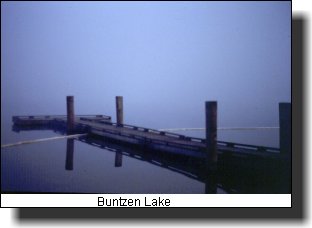 As summer progresses many of the alpine lakes become ice free. The alpine lakes near Whistler just a few hours north of Vancouver are a popular choice. Others to try include Cougar, Madley, Loggers and the Showh lakes. The Showh lakes are among the best lakes in the region. Fish in some of these lakes can grow to 20 inches. Another opportunity for the stillwater angler is some of the high alpine lakes that are only accessible via helicopter. Both the Whistler area and Chilliwack area (2 hours east of Vancouver) offer some of the most scenic high alpine fishing you will ever experience. Your fly box should consist of chironomids, Halfbacks, Doc Spratleys, and Woolly Buggers. For dry flies the Adams, Mosquito and local favorite Tom Thumb are just fine.
As summer progresses many of the alpine lakes become ice free. The alpine lakes near Whistler just a few hours north of Vancouver are a popular choice. Others to try include Cougar, Madley, Loggers and the Showh lakes. The Showh lakes are among the best lakes in the region. Fish in some of these lakes can grow to 20 inches. Another opportunity for the stillwater angler is some of the high alpine lakes that are only accessible via helicopter. Both the Whistler area and Chilliwack area (2 hours east of Vancouver) offer some of the most scenic high alpine fishing you will ever experience. Your fly box should consist of chironomids, Halfbacks, Doc Spratleys, and Woolly Buggers. For dry flies the Adams, Mosquito and local favorite Tom Thumb are just fine.
The greater Vancouver area also offers the chance to chase summer run Steelhead. While the runs are not what they used to be it is still possible to catch some fine summer run fish. The area was famous for the Coquihalla River. A closure due to poor returns has kept the Coquihalla off limits to anglers for the past couple of years. Hopefully the runs will return someday, as this was a premier summer run river. Other rivers to try include the Seymour and the Chehalis. Typical West Coast summer run equipment will do just fine with dry lines being the norm. Popular patterns include Greased Liners, Green Butt Skunks, Muddlers and Bombers in sizes 8 and up. Stonefly nymphs are worth a toss as you might catch some beautiful Cutthroat in the process, not a bad side effect.
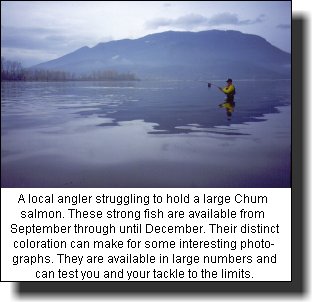 Summer sees the first opportunities for pacific salmon. Returning Coho line up at the mouth of the Capilano River within eyesight of the city's skyline. I find the "Cap" fishes best on an incoming tide with sparsely dressed flies. Local fly shops will give you a handful of the local favorites such as Thornton's beach fly. Often the best tides to fish are in the early morning. Fishing at first light watching the cruise ships arrive on the tide as the sun hits the city is impressive. The middle of August sees the beginning of the large runs of Sockeye running the Fraser to points inland. These can be impressive runs of over 2 million fish that put up an incredible fight. There are a number of popular spots along both sides of the Fraser River such as the Tunnel Bar, Peg Leg and Island 22. Again, local fly shops are your best source of information. Fly rods in the 8 weight range and heavy sink tips or shooting heads work best. Popular patterns feature green materials prominently in their dressings. The Sockeye run is popular with many anglers on weekends and holidays. Expect crowded conditions. Another factor is the commercial openings on the river. These are usually short in duration but can have a dramatic effect on the number of available fish. Finally for the angler who wishes to really test his mettle the Vedder River has a run of Chinook salmon. These brutes can run in excess of 40 pounds. 9 or 10 weight fly rods are a must.
Summer sees the first opportunities for pacific salmon. Returning Coho line up at the mouth of the Capilano River within eyesight of the city's skyline. I find the "Cap" fishes best on an incoming tide with sparsely dressed flies. Local fly shops will give you a handful of the local favorites such as Thornton's beach fly. Often the best tides to fish are in the early morning. Fishing at first light watching the cruise ships arrive on the tide as the sun hits the city is impressive. The middle of August sees the beginning of the large runs of Sockeye running the Fraser to points inland. These can be impressive runs of over 2 million fish that put up an incredible fight. There are a number of popular spots along both sides of the Fraser River such as the Tunnel Bar, Peg Leg and Island 22. Again, local fly shops are your best source of information. Fly rods in the 8 weight range and heavy sink tips or shooting heads work best. Popular patterns feature green materials prominently in their dressings. The Sockeye run is popular with many anglers on weekends and holidays. Expect crowded conditions. Another factor is the commercial openings on the river. These are usually short in duration but can have a dramatic effect on the number of available fish. Finally for the angler who wishes to really test his mettle the Vedder River has a run of Chinook salmon. These brutes can run in excess of 40 pounds. 9 or 10 weight fly rods are a must.
Fall
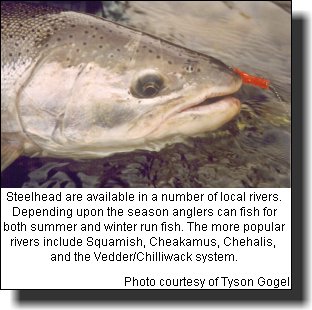 By mid September the runs of pacific salmon are in full swing. In odd numbered years the Vancouver area rivers receive large runs of Pink salmon. These 5 to 8 pound fish are tailor made for the fly fisher. It is possible to get into over 50 fish a day. A 7 or 8 weight system with either a Stillwater or sink tip line is standard equipment. As their name implies, pink flies for Pink salmon, local fly shops have good supplies of simple pink patterns in sizes 6 and 8. Popular rivers include the Vedder, Harrison and mainstream Fraser. Pink Salmon congregate at the mouth of the Seymour as they stage for their journey upstream. Just about every stream and river in the area has a run of Chum salmon. Known locally as, "dogs" these salmon are a real tackle buster. Running upwards of 15 pounds their distinct markings make for great pictures. I would recommend at least an 8 weight system for these brutes as they have the ability to run you all over the place. These aggressive fish are not pattern selective and just about any bright fly pattern will work. After a days fishing your arms may need a few days rest. The most prized salmon for local fly anglers is the Coho. You can fish for Coho on the Harrison, Vedder and many of the small feeder creeks that run into Nicomen Slough. Other notable rivers include the Pitt, Alouette, Nickomekl, and Serpentine. Local fly boxes bristle with orange, red and yellow creations. The Rolled Muddler is a favorite with local fly fishers. An 8 weight rod loaded with a Stillwater or Monocore line is ideal, for faster flows use a sink tip line. You will also catch some of the finest
Cutthroat
and Dollies of the season, as they grow fat upon the rich feast of salmon eggs.
By mid September the runs of pacific salmon are in full swing. In odd numbered years the Vancouver area rivers receive large runs of Pink salmon. These 5 to 8 pound fish are tailor made for the fly fisher. It is possible to get into over 50 fish a day. A 7 or 8 weight system with either a Stillwater or sink tip line is standard equipment. As their name implies, pink flies for Pink salmon, local fly shops have good supplies of simple pink patterns in sizes 6 and 8. Popular rivers include the Vedder, Harrison and mainstream Fraser. Pink Salmon congregate at the mouth of the Seymour as they stage for their journey upstream. Just about every stream and river in the area has a run of Chum salmon. Known locally as, "dogs" these salmon are a real tackle buster. Running upwards of 15 pounds their distinct markings make for great pictures. I would recommend at least an 8 weight system for these brutes as they have the ability to run you all over the place. These aggressive fish are not pattern selective and just about any bright fly pattern will work. After a days fishing your arms may need a few days rest. The most prized salmon for local fly anglers is the Coho. You can fish for Coho on the Harrison, Vedder and many of the small feeder creeks that run into Nicomen Slough. Other notable rivers include the Pitt, Alouette, Nickomekl, and Serpentine. Local fly boxes bristle with orange, red and yellow creations. The Rolled Muddler is a favorite with local fly fishers. An 8 weight rod loaded with a Stillwater or Monocore line is ideal, for faster flows use a sink tip line. You will also catch some of the finest
Cutthroat
and Dollies of the season, as they grow fat upon the rich feast of salmon eggs.
Other fall activities include many of the coastal lakes and beach fishing for cutthroat. There are many low gradient pebble beaches with small feeder creeks that these nomadic trout inhabit. These fish are true ghosts and many anglers spend a lifetime trying to understand their habits in order to be successful. I have had my best success on incoming tides fishing a floating line with a variety of streamer patterns. Fall is also the last opportunity to fish the Skagit. The lower portion is probably your best bet as many of the rainbows are dropping down towards the reservoir in preparation for the upcoming winter. During this time many of the large Dollies that inhabit the Ross Lake reservoir move into the river to spawn. Some of these fish are nearing double digit numbers. Tease large Muddler Minnows or Woolly Buggers through the deep runs and pools.
Winter
Winter is the most limited season of the year but nonetheless there are still opportunities available. In December and January there are still fresh Coho around and the late season often sees runs of large Northern Coho. These fish can run in excess of 15 pounds. By late December the first runs of winter run steelhead are entering the Chilliwack and Vedder River system. By February the run is in full swing. Typical winter steelhead patterns swung patiently through the various runs can yield some great rewards. During the winter the mainstream of the Fraser River is usually low and clear. This is a great time of the year to chase Cutthroat and Dolly Varden. Small streamers and impressionistic nymphs fished on a dry line is a favorite method of mine. Depending upon the temperature you can still find some willing fish in many of the lower mainland lakes. During this time of the year peace and solitude are within easy driving distance.
Planning a Trip
Within the greater Vancouver area there is accommodation to suit all budgets and desires. For travel and accommodation information call the greater Vancouver Tourist info centre at (604) 683-2000 or Supernatural British Columbia at 1-800-663-6000. Once in town there are a number of fly shops to make your stay enjoyable. Most offer guide service or can quickly point you in the right direction. Some of the shops to visit include:
Highwater Tackle
113 Lonsdale Avenue
North Vancouver, B.C.
(604)986-3239
|
Babcock Fly and Tackle
#110 1140 Austin Avenue
Coquitlam, B.C.
(604)931-5044
|
Michael & Young Fly Shop
10484 137 Street
Surrey, B.C.
(604) 588-2833
|
Fred's Custom Tackle
Box 255, 5616 Vedder Road
Vedder Crossing, B.C.
(604)858-7344
|
Hub Sports
33719 Essendene Road
Abbostford, B.C.
(604) 859-8316
|
Whistler Backcountry Adventures
P.O. Box 463
Whistler, B.C.
(604)938-1410
|
|





 Well, it's true.
Well, it's true.  Spring
Spring
 some flow and are almost lake-like, traditional stillwater patterns for
some flow and are almost lake-like, traditional stillwater patterns for  If you don't mind taking a ferry boat ride you can even get yourself into some great Smallmouth fishing on
If you don't mind taking a ferry boat ride you can even get yourself into some great Smallmouth fishing on  Last but not least the spring season offers the opportunity for some fine steelhead fishing. These beautiful sea run Rainbows can attain weights of 12 pounds or better. Popular rivers include the Vedder or Chilliwack River 2 hours east of Vancouver and the Squamish/Cheakamus River 1 to 1.5 hours north of the city. The Vedder run is in full swing by spring. Be warned however this is a hatchery supported run and is subject to heavy pressure at times. On weekends many locals echo the phrase, "bring your own rock". However you should be able to sample some untouched water during mid week if you have the opportunity. The Squamish and Cheakamus River run is a late spring affair with the bulk of the run usually arriving by mid April. It is generally not as crowded as the Vedder/Chilliwack system. The Squamish is a beautiful river to fish. Standing in the river it is possible to see mountain goats, deer, immense numbers of Bald eagles and even the occasional Black or Grizzly bear. Typical West Coast steelhead tackle will do for these magnificent fish. Both single and two handed rods are popular. Popular fly patterns include General Practitioners, Squamish Poachers, marabou patterns such as Popsicles and egg patterns.
Last but not least the spring season offers the opportunity for some fine steelhead fishing. These beautiful sea run Rainbows can attain weights of 12 pounds or better. Popular rivers include the Vedder or Chilliwack River 2 hours east of Vancouver and the Squamish/Cheakamus River 1 to 1.5 hours north of the city. The Vedder run is in full swing by spring. Be warned however this is a hatchery supported run and is subject to heavy pressure at times. On weekends many locals echo the phrase, "bring your own rock". However you should be able to sample some untouched water during mid week if you have the opportunity. The Squamish and Cheakamus River run is a late spring affair with the bulk of the run usually arriving by mid April. It is generally not as crowded as the Vedder/Chilliwack system. The Squamish is a beautiful river to fish. Standing in the river it is possible to see mountain goats, deer, immense numbers of Bald eagles and even the occasional Black or Grizzly bear. Typical West Coast steelhead tackle will do for these magnificent fish. Both single and two handed rods are popular. Popular fly patterns include General Practitioners, Squamish Poachers, marabou patterns such as Popsicles and egg patterns.  The arrival of summer signifies continuing variety for the visiting fly fisher. For the trout fisher the Skagit River roughly 21/2 hours east of Vancouver near the town of
The arrival of summer signifies continuing variety for the visiting fly fisher. For the trout fisher the Skagit River roughly 21/2 hours east of Vancouver near the town of  As summer progresses many of the alpine lakes become ice free. The alpine lakes near Whistler just a few hours north of Vancouver are a popular choice. Others to try include Cougar, Madley, Loggers and the Showh lakes. The Showh lakes are among the best lakes in the region. Fish in some of these lakes can grow to 20 inches. Another opportunity for the stillwater angler is some of the high alpine lakes that are only accessible via helicopter. Both the Whistler area and Chilliwack area (2 hours east of Vancouver) offer some of the most scenic high alpine fishing you will ever experience. Your fly box should consist of chironomids, Halfbacks, Doc Spratleys, and Woolly Buggers. For dry flies the Adams, Mosquito and local favorite Tom Thumb are just fine.
As summer progresses many of the alpine lakes become ice free. The alpine lakes near Whistler just a few hours north of Vancouver are a popular choice. Others to try include Cougar, Madley, Loggers and the Showh lakes. The Showh lakes are among the best lakes in the region. Fish in some of these lakes can grow to 20 inches. Another opportunity for the stillwater angler is some of the high alpine lakes that are only accessible via helicopter. Both the Whistler area and Chilliwack area (2 hours east of Vancouver) offer some of the most scenic high alpine fishing you will ever experience. Your fly box should consist of chironomids, Halfbacks, Doc Spratleys, and Woolly Buggers. For dry flies the Adams, Mosquito and local favorite Tom Thumb are just fine.  Summer sees the first opportunities for pacific salmon. Returning Coho line up at the mouth of the Capilano River within eyesight of the city's skyline. I find the "Cap" fishes best on an incoming tide with sparsely dressed flies. Local fly shops will give you a handful of the local favorites such as Thornton's beach fly. Often the best tides to fish are in the early morning. Fishing at first light watching the cruise ships arrive on the tide as the sun hits the city is impressive. The middle of August sees the beginning of the large runs of Sockeye running the Fraser to points inland. These can be impressive runs of over 2 million fish that put up an incredible fight. There are a number of popular spots along both sides of the Fraser River such as the Tunnel Bar, Peg Leg and Island 22. Again, local fly shops are your best source of information. Fly rods in the 8 weight range and heavy sink tips or shooting heads work best. Popular patterns feature green materials prominently in their dressings. The Sockeye run is popular with many anglers on weekends and holidays. Expect crowded conditions. Another factor is the commercial openings on the river. These are usually short in duration but can have a dramatic effect on the number of available fish. Finally for the angler who wishes to really test his mettle the Vedder River has a run of Chinook salmon. These brutes can run in excess of 40 pounds. 9 or 10 weight fly rods are a must.
Summer sees the first opportunities for pacific salmon. Returning Coho line up at the mouth of the Capilano River within eyesight of the city's skyline. I find the "Cap" fishes best on an incoming tide with sparsely dressed flies. Local fly shops will give you a handful of the local favorites such as Thornton's beach fly. Often the best tides to fish are in the early morning. Fishing at first light watching the cruise ships arrive on the tide as the sun hits the city is impressive. The middle of August sees the beginning of the large runs of Sockeye running the Fraser to points inland. These can be impressive runs of over 2 million fish that put up an incredible fight. There are a number of popular spots along both sides of the Fraser River such as the Tunnel Bar, Peg Leg and Island 22. Again, local fly shops are your best source of information. Fly rods in the 8 weight range and heavy sink tips or shooting heads work best. Popular patterns feature green materials prominently in their dressings. The Sockeye run is popular with many anglers on weekends and holidays. Expect crowded conditions. Another factor is the commercial openings on the river. These are usually short in duration but can have a dramatic effect on the number of available fish. Finally for the angler who wishes to really test his mettle the Vedder River has a run of Chinook salmon. These brutes can run in excess of 40 pounds. 9 or 10 weight fly rods are a must.  By mid September the runs of pacific salmon are in full swing. In odd numbered years the Vancouver area rivers receive large runs of Pink salmon. These 5 to 8 pound fish are tailor made for the fly fisher. It is possible to get into over 50 fish a day. A 7 or 8 weight system with either a Stillwater or sink tip line is standard equipment. As their name implies, pink flies for Pink salmon, local fly shops have good supplies of simple pink patterns in sizes 6 and 8. Popular rivers include the Vedder, Harrison and mainstream Fraser. Pink Salmon congregate at the mouth of the Seymour as they stage for their journey upstream. Just about every stream and river in the area has a run of Chum salmon. Known locally as, "dogs" these salmon are a real tackle buster. Running upwards of 15 pounds their distinct markings make for great pictures. I would recommend at least an 8 weight system for these brutes as they have the ability to run you all over the place. These aggressive fish are not pattern selective and just about any bright fly pattern will work. After a days fishing your arms may need a few days rest. The most prized salmon for local fly anglers is the Coho. You can fish for Coho on the Harrison, Vedder and many of the small feeder creeks that run into Nicomen Slough. Other notable rivers include the Pitt, Alouette, Nickomekl, and Serpentine. Local fly boxes bristle with orange, red and yellow creations. The Rolled Muddler is a favorite with local fly fishers. An 8 weight rod loaded with a Stillwater or Monocore line is ideal, for faster flows use a sink tip line. You will also catch some of the finest
By mid September the runs of pacific salmon are in full swing. In odd numbered years the Vancouver area rivers receive large runs of Pink salmon. These 5 to 8 pound fish are tailor made for the fly fisher. It is possible to get into over 50 fish a day. A 7 or 8 weight system with either a Stillwater or sink tip line is standard equipment. As their name implies, pink flies for Pink salmon, local fly shops have good supplies of simple pink patterns in sizes 6 and 8. Popular rivers include the Vedder, Harrison and mainstream Fraser. Pink Salmon congregate at the mouth of the Seymour as they stage for their journey upstream. Just about every stream and river in the area has a run of Chum salmon. Known locally as, "dogs" these salmon are a real tackle buster. Running upwards of 15 pounds their distinct markings make for great pictures. I would recommend at least an 8 weight system for these brutes as they have the ability to run you all over the place. These aggressive fish are not pattern selective and just about any bright fly pattern will work. After a days fishing your arms may need a few days rest. The most prized salmon for local fly anglers is the Coho. You can fish for Coho on the Harrison, Vedder and many of the small feeder creeks that run into Nicomen Slough. Other notable rivers include the Pitt, Alouette, Nickomekl, and Serpentine. Local fly boxes bristle with orange, red and yellow creations. The Rolled Muddler is a favorite with local fly fishers. An 8 weight rod loaded with a Stillwater or Monocore line is ideal, for faster flows use a sink tip line. You will also catch some of the finest 